How To Check For Apps Running In The Background
So. Much. Stuff.
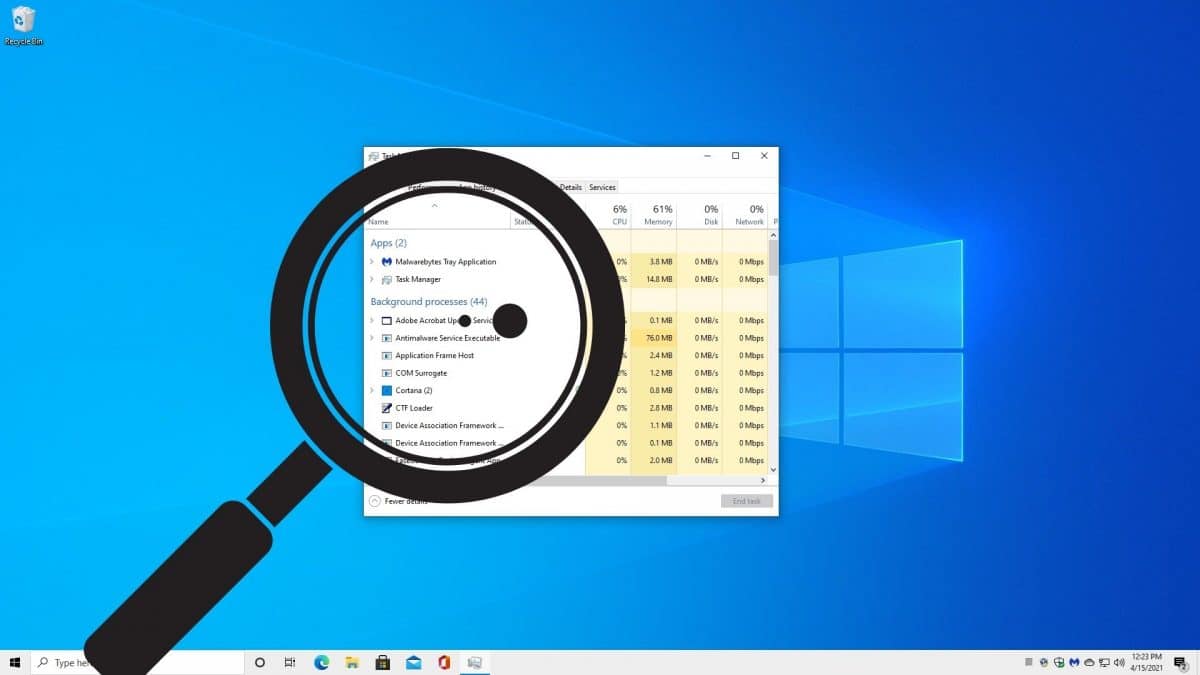
Windows runs a lot of software fifty-fifty when y'all're doing nothing at all. We'll dive into how to examine what's really running, and what to do with the information you glean.
I've not run anything at all, but my estimator'southward working hard. Why? Is there stuff running I tin't see? How do I tell?
Aye, there's stuff running that you can't see. In recent versions of Windows, a downright amazing amount of stuff.
The good news is that at that place are ways to notice out what's running. The bad news is that information technology's not always clear what to practise near it.

What'due south in the Background?
Start in the taskbar notification expanse (with all icons ever displayed) for a quick sense of some of the applications running in the background. And so, using Task Director's "Process" view, yous tin see a more consummate list of applications currently running. The "Details" view lists every executable program running, and the "Services" view organizes those that correspond Windows services into a more manageable listing. Unfortunately, in that location's no guideline for what should and should not be running, every bit it depends entirely on the software you run, the configuration of your machine, and the options you've selected.
The taskbar notification area
I'll start with a list of running apps you can see pretty easily, although nosotros don't e'er pay attention to it: the notification area.
First, make sure you're seeing all the notification icons. If yous see an upwardly pointing caret, you lot're non.

Click the Start push button and search for "Select which icons appear on the taskbar". In the resulting settings page, brand certain "Always show all icons in the notification area" is turned on.
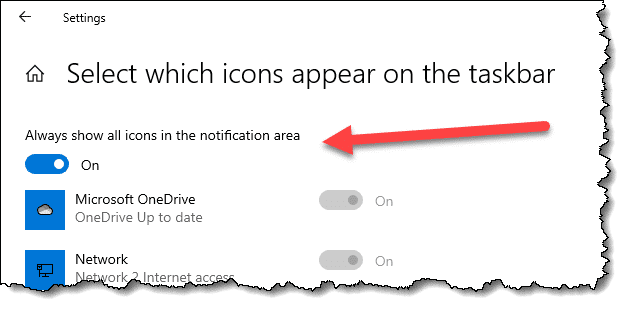
Once you practice that, you'll see more icons appear in the notification area.

In my case, only three icons announced, but I've seen many machines where nearly a dozen icons or more than would announced. My work machine has 23 as I blazon this.
Each icon represents at least one running programme. The example higher up includes (from left to correct):
- VirtualBox Guest Additions (Software that enhances this virtual machine's interface to the real machine on which it's running.)
- Window Security
- Malwarebytes (Free)
- OneDrive
- Network connection
- Book control
I can't tell y'all what should and should not exist running here. It depends on what software you lot've chosen to install and run, the options you've specified, your machine's configuration, and even its hardware. But this gives you lot quick visibility into some of the programs running on your estimator fifty-fifty when you're doing "zippo".
To explore deeper, we demand to run a different tool.
Job Manager
Correct-click on the clock and click Task Manager.
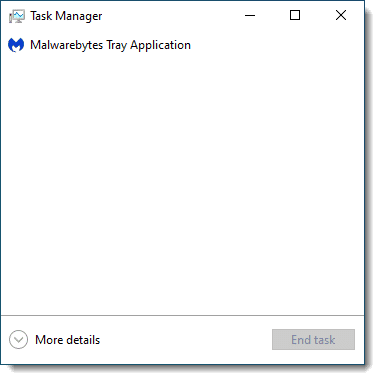
The basic view displays programs that are open, and since we oasis't run anything, the list is pretty pocket-sized.
Click More details.

This is a great place to start, since information technology tends to evidence programs past the name(s) you might recognize. Curlicue through and you'll meet many familiar names — software yous've installed, perhaps — and several unfamiliar items — components of Windows itself, or software specific to your hardware configuration, for instance.
But nosotros can swoop deeper still. Click on the Details tab.

Here we cantankerous into the realm of the geeky. Information technology's the list of every "executable" (.exe) program currently running on your machine.
Click the Services tab for a view that tin can help make sense of some of the detailed entries.

The Service view lists both running and non-running services. In the example above, I've clicked on the "Condition" header to sort the list so that "Running" services are shown first.
Services are more often than not implemented past a unmarried executable: "svchost.exe". In the Details tab, you'll encounter many copies of Service Host, as it's known, running. The Services tab lets yous see which services all those svchosts are running.
Additional tools
There are two additional tools yous tin use to display the same information nosotros've shown higher up in slightly unlike ways. I find myself gravitating towards these tools considering they're more than consummate and more comfortable — for me at least.
Process Explorer is essentially a replacement for Task Managing director.
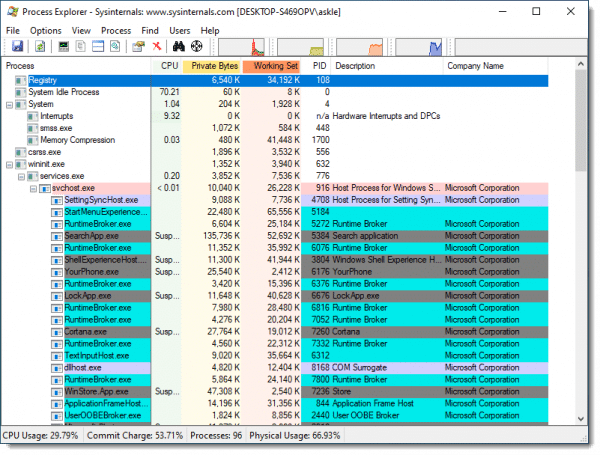
While it may look more than intimidating, information technology exposes more data than Task Manager, and that can exist helpful in determining what each entry represents.
The other is the built-in Service Direction console. Correct-click on the Start button, click on Calculator Direction, and in the resulting window, click on the ">" next to "Services and Applications". So click on Services.
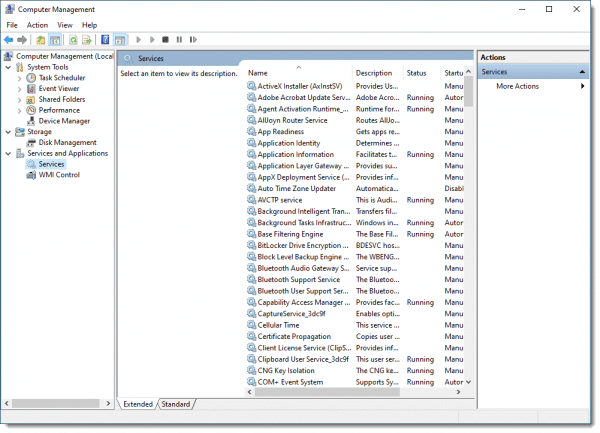
Once again, equally compared to Task Managing director, the Services panel provides more data most the services running on your machine. (You'll even see a link — "Open Services" — at the bottom of the Task Manager Services tab, which volition also open this view.)
And then what are they?
Programs, processes, services, executables … but what are they all?
Some will be obvious from their name. Others, not and so much. The but real advice I tin offer hither is to search for the names you find listed in Task Manager, Process Explorer, or the Services console.
Important: many sites in the search results volition imply that what you've searched for could be malware, and that they take a tool y'all should download and purchase to remove it. DO Not BELIEVE THEM. Unless your security software has already told y'all they're malware, they're very unlikely to be malicious. Information technology's a scare tactic these sites use to sell you lot software you don't need.
Expect for sites that give clear explanations of what the software is, what information technology's related to, and what it does for you. Generally, you'll notice it's a component of Windows or a part of a software package you will recognize as having installed.
Do I need them all?
Much similar the information we got from the notifications area, I tin't tell yous what should and should not be running on your motorcar. It depends on what software y'all've chosen to install and run, the options you've specified, your machine's configuration, and even its hardware.
The goal hither is to assistance you identify what's running so you can research it and make a conclusion for yourself on whether or not it's something you want.
Nigh of the time, it is. When it isn't, nigh of the time the solution is to uninstall the application you lot've decided you don't need or want.
But exactly which ones those might be, only y'all can say.
Podcast audio
How To Check For Apps Running In The Background,
Source: https://askleo.com/how-to-tell-whats-running-in-the-background-on-your-pc/
Posted by: scottwhaption.blogspot.com


0 Response to "How To Check For Apps Running In The Background"
Post a Comment